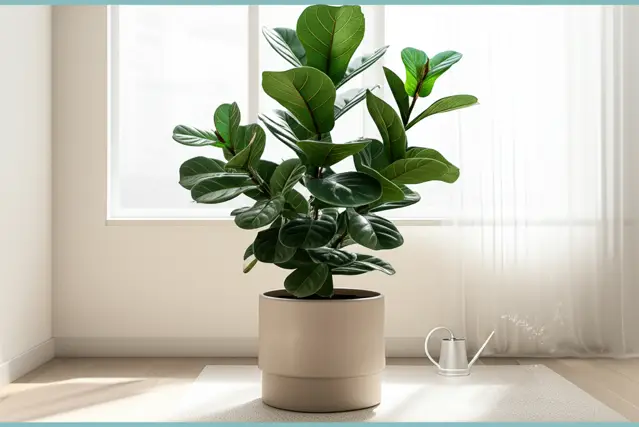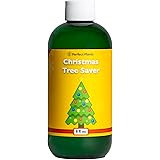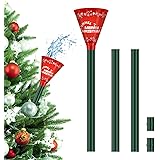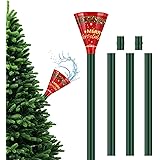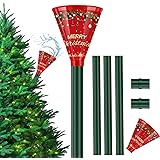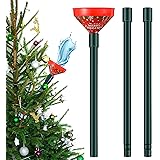The Fiddle Leaf Fig (Ficus lyrata) – with its dramatic, violin-shaped leaves – has become a staple in interior design, gracing homes and offices worldwide. Its popularity is undeniable, driven by its sculptural presence and ability to bring a touch of the tropics indoors. However, this coveted houseplant is also notorious for being…well, a bit dramatic itself. Understanding the causes of fiddle leaf fig leaf drop is the first step to reviving your precious plant.
This comprehensive guide, updated for 2024, dives deep into the 6 most frequent culprits behind leaf drop in Fiddle Leaf Figs. We’ll not only identify these issues but also provide practical, actionable solutions to get your FLF back to its thriving best. We’ll also explore current trends in plant care, discuss relevant statistics, and even touch on evolving regulations concerning houseplant sourcing and health.
The Fiddle Leaf Fig Phenomenon: Why Are They So Popular?
Before we delve into the problems, let’s acknowledge the plant’s allure. The Fiddle Leaf Fig’s rise to stardom is partly attributed to its aesthetic appeal. Its large, glossy leaves create a statement, adding a touch of sophistication and natural beauty to any space. Social media platforms like Instagram and Pinterest have further fueled its popularity, showcasing FLFs in stylishly decorated homes. According to a recent survey by the National Garden Bureau, indoor plant sales have increased by over 20% in the past five years, with Fiddle Leaf Figs consistently ranking among the top choices.
But with great beauty comes great responsibility (and potential challenges!). The Fiddle Leaf Fig can be a bit finicky, requiring specific conditions to thrive. Ignoring these needs can quickly lead to problems, with leaf drop being a prime indicator of distress. Don’t worry; most of these issues are easily addressed once you understand the plant’s requirements.
Understanding Leaf Drop: Is It Always a Bad Sign?
It’s important to note that not all leaf drop is a cause for immediate panic. Mature Fiddle Leaf Figs naturally shed their older, lower leaves as they grow. This is a normal part of the plant’s life cycle, as it focuses its energy on new growth at the top. However, if you observe a sudden and significant drop of leaves, especially if those leaves are otherwise healthy-looking (green, without spots or browning), then it’s definitely time to investigate.
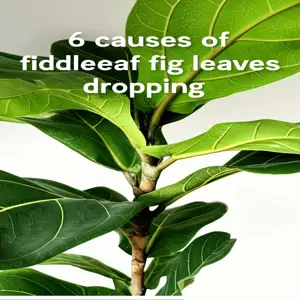
Fiddle Leaf Fig Care
Here’s a quick checklist to determine if the leaf drop is normal or a sign of a problem:
- Location of the leaves: Are they primarily the oldest, lowest leaves? This is more likely to be natural shedding.
- Number of leaves: Is it just a few leaves, or a large percentage of the plant’s foliage? A few leaves are normal; many are not.
- Appearance of the leaves: Are the leaves yellowing, browning, spotted, or otherwise unhealthy-looking before they drop? If so, there’s likely an underlying issue.
- Season: Plants often shed leaves during seasonal changes, particularly in the fall and winter when light levels decrease.
6 Common Causes of Fiddle Leaf Fig Leaf Drop (and How to Fix Them)
Let’s dive into the most common reasons why your Fiddle Leaf Fig might be shedding its leaves. For each cause, we’ll provide a detailed explanation, symptoms to look for, and actionable solutions to remedy the problem.
Read More: Can Monstera Get Sunburn? Preventing Leaf Damage
1. Watering Issues: The Double-Edged Sword
Watering is arguably the most critical aspect of Fiddle Leaf Fig care. Both overwatering and underwatering can lead to leaf drop, and it can be tricky to strike the right balance. The key is to understand your plant’s needs and adjust your watering schedule accordingly. A recent report from the University of California Agriculture and Natural Resources highlights that improper watering is the leading cause of houseplant death in the United States.
Overwatering: A Recipe for Root Rot
Overwatering is a more common problem than underwatering, and it’s often fatal if left unaddressed. When the soil remains constantly saturated, the roots are deprived of oxygen, leading to root rot. Root rot, caused by fungal pathogens, prevents the plant from absorbing water and nutrients, ultimately causing leaf drop.
Symptoms of Overwatering:
- Yellowing leaves, especially starting at the bottom of the plant. This is often accompanied by brown spots.
- Drooping leaves, even when the soil is wet.
- Soft, mushy brown spots on the leaves.
- Foul odor coming from the soil. This is a telltale sign of root rot.
- Stunted growth.
Solutions for Overwatering:
- Check the soil moisture: Before watering, stick your finger about 2 inches into the soil. If it feels damp, do not water. Consider using a moisture meter for more accurate readings.
- Improve drainage: Ensure your pot has adequate drainage holes. If the soil is compacted, repot the plant into a well-draining potting mix. A mix specifically designed for Fiddle Leaf Figs is ideal.
- Repotting: If you suspect root rot, carefully remove the plant from its pot and inspect the roots. Healthy roots are firm and light-colored, while rotted roots are mushy, brown, and may have a foul odor. Cut away any rotted roots with sterile pruning shears. Repot the plant in fresh, well-draining potting mix and a clean pot. You may want to treat the remaining roots with a fungicide specifically designed for root rot, following the manufacturer’s instructions.
- Reduce watering frequency: Allow the top inch or two of soil to dry out completely before watering. During the winter months, when the plant is dormant, you’ll need to water even less frequently.
- Increase air circulation: Good air circulation helps the soil dry out faster. Consider placing a small fan near the plant to improve airflow.
Real-world example: A friend of mine, Sarah, noticed her Fiddle Leaf Fig was dropping leaves and the lower leaves were turning yellow. She was watering it every week, thinking she was being diligent. After examining the soil, she realized it was constantly wet. She repotted the plant, removed the rotted roots, and significantly reduced her watering frequency. The plant bounced back and is now thriving.
Underwatering: Dehydration Stress
While overwatering is more common, underwatering can also cause significant problems. When the plant doesn’t receive enough water, it becomes stressed and starts to shed leaves to conserve moisture.
Symptoms of Underwatering:
- Crispy, brown edges on the leaves, especially on the lower leaves.
- Drooping leaves that feel dry and brittle.
- Dry, cracked soil.
- Slow or stunted growth.
Solutions for Underwatering:
- Check the soil moisture: Again, use your finger or a moisture meter to assess the soil moisture.
- Water thoroughly: When you do water, water deeply until water drains out of the drainage holes. This ensures that the entire root ball is properly hydrated.
- Increase watering frequency: Adjust your watering schedule based on the plant’s needs. During the growing season (spring and summer), you’ll likely need to water more frequently than during the dormant season (fall and winter).
- Consider soaking the pot: If the soil is very dry and compacted, it may be difficult to rehydrate it with regular watering. In this case, try soaking the pot in a tub of water for an hour or two, allowing the soil to absorb water from the bottom.
- Increase humidity: Low humidity can exacerbate the effects of underwatering. Consider using a humidifier, placing the plant on a pebble tray with water, or grouping it with other plants to increase humidity.
Real-world example: Another friend, Mark, noticed his Fiddle Leaf Fig was dropping leaves and the edges were turning brown and crispy. He admitted he often forgot to water it for weeks at a time. He started setting reminders on his phone and increased his watering frequency. The plant quickly recovered and started producing new growth.
2. Insufficient Light: The Silent Killer
Fiddle Leaf Figs are native to tropical rainforests, where they receive bright, indirect sunlight. They need ample light to thrive, and insufficient light is a common cause of leaf drop. According to a study by the American Society for Horticultural Science, adequate light exposure significantly improves the overall health and growth of Fiddle Leaf Figs.
Symptoms of Insufficient Light:
- Leaf drop, especially on the lower parts of the plant.
- Stunted growth.
- Leggy growth (long, stretched stems with few leaves).
- Pale or yellowing leaves.
- Leaves may be smaller than usual.
Solutions for Insufficient Light:
- Relocate the plant: Move your Fiddle Leaf Fig to a location that receives more bright, indirect light. East-facing windows are often ideal, as they provide gentle morning sun. South- or west-facing windows can also work, but be sure to protect the plant from harsh, direct sunlight, which can scorch the leaves.
- Supplement with artificial light: If you don’t have enough natural light, consider using grow lights. Full-spectrum LED grow lights are a good option, as they provide the plant with the light it needs to photosynthesize.
- Rotate the plant: Rotate the plant regularly to ensure that all sides receive adequate light. This will prevent the plant from leaning towards the light source and promote even growth.
- Clean the leaves: Dust and dirt can accumulate on the leaves, blocking sunlight. Clean the leaves regularly with a damp cloth to ensure they can efficiently absorb light.
- Reflect light: Use mirrors or light-colored surfaces to reflect more light onto the plant.
Real-world example: My neighbor, Lisa, kept her Fiddle Leaf Fig in a dark corner of her living room. It was dropping leaves and looked generally unhappy. I suggested she move it closer to a window. She relocated it to a spot near a south-facing window and supplemented with a grow light. The plant immediately started to improve, and the leaf drop stopped.
3. Temperature Fluctuations and Drafts: The Sensitive Soul
Fiddle Leaf Figs are sensitive to temperature fluctuations and drafts. They prefer a consistent temperature between 65°F and 75°F (18°C and 24°C). Sudden changes in temperature or exposure to cold drafts can stress the plant and cause leaf drop. The Environmental Protection Agency (EPA) recommends maintaining stable indoor temperatures for optimal plant health.
Symptoms of Temperature Fluctuations and Drafts:
- Leaf drop, especially near windows or doors.
- Brown, crispy edges on the leaves.
- Curling leaves.
- Stunted growth.
Solutions for Temperature Fluctuations and Drafts:
- Relocate the plant: Move your Fiddle Leaf Fig away from drafty windows, doors, and air vents.
- Maintain a consistent temperature: Avoid placing the plant near heating or cooling sources that can cause temperature fluctuations.
- Insulate windows: If you live in a cold climate, consider insulating your windows to prevent drafts.
- Monitor temperature: Use a thermometer to monitor the temperature around the plant.
- Protect from frost: If temperatures are expected to drop below freezing, bring the plant indoors or provide adequate protection.
Real-world example: I once placed my Fiddle Leaf Fig too close to a drafty window during the winter. The leaves started to curl and drop. I moved it to a warmer, more sheltered location, and the problem resolved itself.
4. Low Humidity: The Desert Effect
Fiddle Leaf Figs thrive in humid environments, similar to their native tropical rainforests. Low humidity can cause the leaves to dry out and drop, especially during the winter months when indoor heating systems tend to dry out the air. According to research published in the journal “HortScience,” maintaining adequate humidity levels is crucial for the health and vigor of tropical houseplants.
Symptoms of Low Humidity:
- Brown, crispy edges on the leaves.
- Leaf drop.
- Stunted growth.
- Yellowing leaves.
Solutions for Low Humidity:
- Use a humidifier: A humidifier is the most effective way to increase humidity around your Fiddle Leaf Fig.
- Place the plant on a pebble tray: Fill a tray with pebbles and water, and place the plant on top. As the water evaporates, it will increase the humidity around the plant. Be sure the bottom of the pot isn’t sitting *in* the water, or it can lead to root rot.
- Group plants together: Grouping plants together creates a more humid microclimate.
- Mist the plant: Misting the leaves regularly can temporarily increase humidity, but it’s not as effective as other methods. Be sure to mist early in the day to allow the leaves to dry before nightfall, which can help prevent fungal diseases.
- Move to a more humid location: Consider moving the plant to a more humid room, such as a bathroom or kitchen.
Real-world example: During the winter, I noticed the leaves on my Fiddle Leaf Fig were starting to develop brown, crispy edges. I realized the humidity in my apartment was very low due to the heating system. I started using a humidifier, and the problem quickly resolved itself.
5. Pest Infestation: The Unseen Enemy
Pests can wreak havoc on your Fiddle Leaf Fig, sucking the sap from the leaves and causing them to weaken and drop. Common pests that affect Fiddle Leaf Figs include spider mites, mealybugs, scale, and aphids. The USDA Animal and Plant Health Inspection Service (APHIS) regulates the import and export of plants to prevent the spread of pests and diseases.
Symptoms of Pest Infestation:
- Leaf drop.
- Yellowing or browning leaves.
- Small webs on the leaves or stems (spider mites).
- Cottony white masses on the leaves or stems (mealybugs).
- Small, brown, scale-like bumps on the leaves or stems (scale).
- Sticky residue on the leaves (honeydew, secreted by aphids and scale).
- Deformed or distorted leaves.
Solutions for Pest Infestation:
- Inspect the plant regularly: Check the leaves and stems for signs of pests.
- Isolate the plant: If you find pests, isolate the plant from other plants to prevent the infestation from spreading.
- Wipe down the leaves: Use a damp cloth or cotton swab to wipe away pests from the leaves and stems.
- Spray with insecticidal soap or neem oil: Insecticidal soap and neem oil are effective treatments for many common plant pests. Follow the manufacturer’s instructions carefully.
- Use horticultural oil: Horticultural oil can also be used to control pests.
- Introduce beneficial insects: In some cases, you can introduce beneficial insects, such as ladybugs or lacewings, to control pest populations.
- Repot the plant: In severe cases, you may need to repot the plant with fresh potting mix to remove any pests that are living in the soil.
Real-world example: I once discovered a spider mite infestation on my Fiddle Leaf Fig. I isolated the plant, wiped down the leaves, and sprayed it with insecticidal soap. I repeated the treatment several times, and the infestation was eventually eradicated.
6. Stress and Acclimation: The Moving Blues
Fiddle Leaf Figs are sensitive to changes in their environment. Moving the plant to a new location, repotting it, or even changing the lighting can stress the plant and cause leaf drop. It can take time for a Fiddle Leaf Fig to acclimate to a new environment. The American Horticultural Society recommends gradual acclimation for sensitive plants like the Fiddle Leaf Fig.
Symptoms of Stress and Acclimation:
- Leaf drop.
- Yellowing or browning leaves.
- Stunted growth.
- Drooping leaves.
Solutions for Stress and Acclimation:
- Provide a stable environment: Avoid making frequent changes to the plant’s environment.
- Gradually acclimate the plant: When moving the plant to a new location, gradually introduce it to the new conditions. For example, if you’re moving the plant from a shady location to a sunnier location, start by placing it in the new location for a few hours each day and gradually increase the exposure time.
- Avoid repotting unnecessarily: Only repot the plant when it’s absolutely necessary, such as when it’s root-bound or when the soil is severely compacted.
- Provide proper care: Ensure the plant is receiving adequate light, water, and humidity.
- Be patient: It can take several weeks or even months for a Fiddle Leaf Fig to fully acclimate to a new environment.
Read More: Why Is My Evergreen Arborvitae Turning Yellow? Exploring Causes And Solutions
Real-world example: I recently repotted my Fiddle Leaf Fig, and it dropped a few leaves in the following weeks. I knew this was likely due to the stress of repotting, so I made sure to provide it with optimal care and be patient. The plant eventually recovered and started to thrive again.
Advanced Troubleshooting: When the Basics Don’t Work
Sometimes, leaf drop can be caused by a combination of factors or by a more complex issue. If you’ve addressed the basic causes mentioned above and your Fiddle Leaf Fig is still dropping leaves, consider these advanced troubleshooting steps:
- Soil pH: Test the soil pH to ensure it’s within the optimal range for Fiddle Leaf Figs (6.0-7.0). You can purchase a soil pH testing kit at most garden centers. If the pH is too high or too low, amend the soil accordingly.
- Nutrient deficiencies: Fiddle Leaf Figs can suffer from nutrient deficiencies, which can lead to leaf drop. Fertilize the plant regularly with a balanced liquid fertilizer, following the manufacturer’s instructions. A fertilizer specifically formulated for Fiddle Leaf Figs is ideal.
- Root-bound: If the plant is severely root-bound, it may not be able to absorb enough water and nutrients. Repot the plant into a larger pot with fresh potting mix.
- Disease: Fiddle Leaf Figs can be susceptible to various diseases, such as fungal leaf spot and bacterial blight. If you suspect your plant has a disease, consult with a local nursery or plant expert for diagnosis and treatment options.
- Water Quality: Hard water, or water containing high levels of chlorine or fluoride, can sometimes negatively impact Fiddle Leaf Figs. Consider using filtered water or letting tap water sit out for 24 hours before using it to water your plant.
Preventative Care: Keeping Your Fiddle Leaf Fig Happy and Healthy
The best way to avoid leaf drop is to provide your Fiddle Leaf Fig with consistent, proper care from the start. Here’s a summary of preventative measures:
- Watering: Allow the top inch or two of soil to dry out completely before watering. Water thoroughly until water drains out of the drainage holes.
- Light: Provide bright, indirect sunlight.
- Temperature: Maintain a consistent temperature between 65°F and 75°F (18°C and 24°C).
- Humidity: Maintain adequate humidity levels.
- Fertilizing: Fertilize regularly with a balanced liquid fertilizer.
- Pest control: Inspect the plant regularly for pests and take action promptly if you find any.
- Repotting: Repot only when necessary.
- Cleaning: Clean the leaves regularly to remove dust and dirt.
- Rotation: Rotate the plant regularly to ensure even growth.
By following these preventative care tips, you can create a thriving environment for your Fiddle Leaf Fig and minimize the risk of leaf drop.
Current Trends in Fiddle Leaf Fig Care: One emerging trend is the use of self-watering pots and systems for Fiddle Leaf Figs. These systems can help to maintain consistent moisture levels and prevent overwatering or underwatering. Another trend is the increasing popularity of using organic and sustainable plant care products.
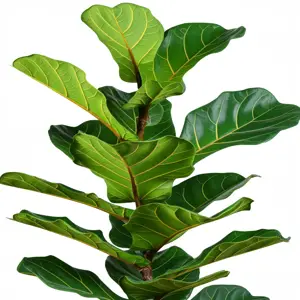
Plant Health Problems
Regulations and Considerations: While there aren’t specific regulations solely for Fiddle Leaf Fig ownership, there are increasing concerns and discussions surrounding the ethical and sustainable sourcing of houseplants. Consumers are becoming more aware of the environmental impact of transporting plants long distances and the potential for introducing invasive species. Look for nurseries that prioritize sustainable practices and source their plants responsibly.
Table Summarizing Causes and Solutions
| Cause | Symptoms | Solutions |
|---|---|---|
| Overwatering | Yellowing leaves, drooping leaves, soft brown spots, foul odor from soil | Improve drainage, repot with fresh soil, reduce watering frequency, increase air circulation |
| Underwatering | Crispy brown edges, drooping leaves, dry soil | Water thoroughly, increase watering frequency, consider soaking the pot, increase humidity |
| Insufficient Light | Leaf drop, stunted growth, leggy growth, pale leaves | Relocate the plant, supplement with artificial light, rotate the plant, clean the leaves, reflect light |
| Temperature Fluctuations/Drafts | Leaf drop near windows/doors, crispy edges, curling leaves | Relocate the plant, maintain consistent temperature, insulate windows, monitor temperature |
| Low Humidity | Crispy brown edges, leaf drop, stunted growth | Use a humidifier, place on a pebble tray, group plants together, mist the plant |
| Pest Infestation | Leaf drop, yellowing leaves, webs, cottony masses, scale | Inspect regularly, isolate the plant, wipe down leaves, use insecticidal soap or neem oil |
| Stress/Acclimation | Leaf drop, yellowing leaves, stunted growth, drooping leaves | Provide a stable environment, gradually acclimate, avoid unnecessary repotting, provide proper care, be patient |
FAQ: Frequently Asked Questions About Fiddle Leaf Fig Leaf Drop
Here are some of the most common questions people have about Fiddle Leaf Fig leaf drop, along with detailed answers.
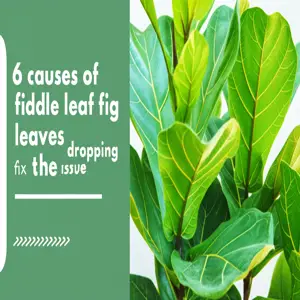
Leaf Drop Causes
Why are the lower leaves of my Fiddle Leaf Fig turning yellow and dropping?
Yellowing and dropping of lower leaves can be a sign of several issues. The most common culprits are overwatering, insufficient light, or natural shedding of older leaves. Check the soil moisture to rule out overwatering. Ensure the plant is receiving adequate light. If only a few of the very lowest leaves are affected, it may simply be natural aging.
My Fiddle Leaf Fig is dropping healthy-looking green leaves. What could be the cause?
Dropping healthy-looking green leaves is often a sign of stress. This could be due to sudden changes in the plant’s environment, such as a change in temperature, light, or humidity. It could also be due to overwatering or underwatering. Examine your care routine and try to identify any recent changes or inconsistencies. Also consider the possibility of root shock from recent repotting.
How often should I water my Fiddle Leaf Fig?
There’s no one-size-fits-all answer to this question. The frequency of watering depends on several factors, including the size of the pot, the type of potting mix, the temperature, and the humidity. A good rule of thumb is to allow the top inch or two of soil to dry out completely before watering. In general, you’ll likely need to water more frequently during the growing season (spring and summer) than during the dormant season (fall and winter). Always check the soil moisture before watering. A moisture meter can be a helpful tool.
What kind of light does a Fiddle Leaf Fig need?
Fiddle Leaf Figs need bright, indirect sunlight. Avoid placing the plant in direct sunlight, which can scorch the leaves. An east-facing window is often ideal, as it provides gentle morning sun. South- or west-facing windows can also work, but be sure to protect the plant from harsh, direct sunlight. If you don’t have enough natural light, consider using grow lights.
What is the best potting mix for a Fiddle Leaf Fig?
Fiddle Leaf Figs need a well-draining potting mix. A mix specifically designed for Fiddle Leaf Figs is ideal. You can also create your own mix by combining equal parts potting soil, perlite, and coco coir or orchid bark. Avoid using heavy, compacted soil, which can lead to root rot.
How can I increase the humidity around my Fiddle Leaf Fig?
There are several ways to increase the humidity around your Fiddle Leaf Fig. You can use a humidifier, place the plant on a pebble tray with water, group it with other plants, or mist the leaves regularly. A humidity meter can help you monitor the humidity levels in your home.
What are common pests that affect Fiddle Leaf Figs?
Common pests that affect Fiddle Leaf Figs include spider mites, mealybugs, scale, and aphids. Inspect the plant regularly for signs of pests. If you find pests, take action promptly to prevent the infestation from spreading. Insecticidal soap and neem oil are effective treatments for many common plant pests.
How often should I fertilize my Fiddle Leaf Fig?
Fertilize your Fiddle Leaf Fig regularly during the growing season (spring and summer). Use a balanced liquid fertilizer, following the manufacturer’s instructions. A fertilizer specifically formulated for Fiddle Leaf Figs is ideal. Avoid fertilizing during the dormant season (fall and winter).
Why are the edges of my Fiddle Leaf Fig’s leaves turning brown and crispy?
Brown, crispy edges on the leaves are often a sign of low humidity or underwatering. Ensure the plant is receiving adequate humidity and that you are watering it properly. Also consider the possibility of fertilizer burn if you’ve recently fertilized the plant.
How can I tell if my Fiddle Leaf Fig has root rot?
Signs of root rot include yellowing leaves, drooping leaves, soft, mushy brown spots on the leaves, and a foul odor coming from the soil. To confirm root rot, carefully remove the plant from its pot and inspect the roots. Healthy roots are firm and light-colored, while rotted roots are mushy, brown, and may have a foul odor. If you suspect root rot, act quickly to save the plant by repotting it with fresh soil and removing any rotted roots.
Conclusion: The Journey to a Thriving Fiddle Leaf Fig
The Fiddle Leaf Fig, with its striking beauty and undeniable presence, is a rewarding addition to any indoor space. While it may have a reputation for being a bit temperamental, understanding its needs and addressing issues promptly will pave the way for a long and healthy life for your plant. Leaf drop, while concerning, is often a symptom of an underlying problem that can be resolved with the right care and attention.
Remember to focus on the fundamentals: proper watering, adequate light, stable temperature, sufficient humidity, and regular pest control. Be observant, pay attention to your plant’s cues, and adjust your care routine accordingly. Don’t be afraid to experiment and learn what works best for your specific environment. Just as every home is unique, so too are the individual needs of each Fiddle Leaf Fig. Consider this article as your guide.
The world of houseplant care is constantly evolving, with new research, products, and techniques emerging all the time. Stay informed by reading reputable gardening blogs, consulting with local nurseries, and connecting with other plant enthusiasts. Embracing sustainable practices, such as using organic fertilizers and sourcing plants responsibly, will not only benefit your Fiddle Leaf Fig but also contribute to a healthier environment.
By investing your time and effort in understanding your Fiddle Leaf Fig, you’re not just growing a plant; you’re cultivating a connection with nature and creating a living work of art that will bring joy and beauty to your home for years to come. So, take a deep breath, embrace the challenge, and enjoy the journey of nurturing your Fiddle Leaf Fig to its full potential.
Auto Amazon Links: No products found.
Perfect Plants Christmas Tree Saver 8oz. | Easy Use Xmas Tree Preserver Food | Have Healthy Green Christmas Trees All Holiday Season
$9.97 (as of December 3, 2025 00:36 GMT +00:00 - More info- Product prices and availability are accurate as of the date/time indicated and are subject to change. Any price and availability information displayed on [relevant Amazon Site(s), as applicable] at the time of purchase will apply to the purchase of this product.
Kaiedos Christmas Tree Watering Funnel - 39 Inch Funnel, Reusable Design, Makes Watering Your Live Tree a Snap!
$14.99 (as of December 3, 2025 00:36 GMT +00:00 - More info- Product prices and availability are accurate as of the date/time indicated and are subject to change. Any price and availability information displayed on [relevant Amazon Site(s), as applicable] at the time of purchase will apply to the purchase of this product.
Christmas Tree Watering Funnel, Real Christmas Tree Water Long Funnel About 40 Inch, Trees Watering System for Water Indoor Outdoor
$15.99 (as of December 3, 2025 00:36 GMT +00:00 - More info- Product prices and availability are accurate as of the date/time indicated and are subject to change. Any price and availability information displayed on [relevant Amazon Site(s), as applicable] at the time of purchase will apply to the purchase of this product.
IPOOLTENG Christmas Tree Watering Funnel 3 Tube 1 Funnels 40 Inch - 3 Section Plastic Christmas Tree Funnel Waterer, Long Funnels for Watering Trees, Best Gifts for Your Parents to Water Tree
$15.53 (as of December 3, 2025 00:36 GMT +00:00 - More info- Product prices and availability are accurate as of the date/time indicated and are subject to change. Any price and availability information displayed on [relevant Amazon Site(s), as applicable] at the time of purchase will apply to the purchase of this product.
1 Pack Christmas Tree Watering Funnel System, 44 Inch Christmas Tree Watering Stick with Adjustable 3-Section Design, Reusable & Spill-Free, Xmas Plant Waterer Tool for Indoor and Outdoor
$16.99 (as of December 3, 2025 00:36 GMT +00:00 - More info- Product prices and availability are accurate as of the date/time indicated and are subject to change. Any price and availability information displayed on [relevant Amazon Site(s), as applicable] at the time of purchase will apply to the purchase of this product.
Cuisinart 6.5" Cast Iron Smashed Burger Press, Round Flat Edge Grill Press for Crispy Smash Burgers, Burger Tool for Grill and Griddle Accessories, for BBQs and Tailgates
$24.99 (as of December 3, 2025 16:48 GMT +00:00 - More info- Product prices and availability are accurate as of the date/time indicated and are subject to change. Any price and availability information displayed on [relevant Amazon Site(s), as applicable] at the time of purchase will apply to the purchase of this product.
Muddy Mat® Shown on TV Super Absorbent Microfiber Dog Door Mat for Muddy Paws, Non-Slip Washable Pet Rug, Quick Dry Chenille Entryway Carpet, Machine Washable Indoor Outdoor mat, Grey 30"x19"
$19.95 (as of December 3, 2025 16:48 GMT +00:00 - More info- Product prices and availability are accurate as of the date/time indicated and are subject to change. Any price and availability information displayed on [relevant Amazon Site(s), as applicable] at the time of purchase will apply to the purchase of this product.
Snow Joe Premium Enviro Blend Ice Melt, Green-Coated Deicer Crystals, 50 lb - Safer Melter for Vegetation, Concrete & Metals w/ Anti-Corrosion Calcium Magnesium Acetate
$32.97 (as of December 3, 2025 16:48 GMT +00:00 - More info- Product prices and availability are accurate as of the date/time indicated and are subject to change. Any price and availability information displayed on [relevant Amazon Site(s), as applicable] at the time of purchase will apply to the purchase of this product.
OLANLY Dog Door Mat for Muddy Paws 30x20, Absorbs Moisture and Dirt, Absorbent Non-Slip Washable Doormat, Quick Dry Chenille Mud Mat for Dogs, Entry Indoor Entryway Carpet for Inside Floor, Grey
$9.99 (as of December 3, 2025 16:48 GMT +00:00 - More info- Product prices and availability are accurate as of the date/time indicated and are subject to change. Any price and availability information displayed on [relevant Amazon Site(s), as applicable] at the time of purchase will apply to the purchase of this product.
Zevo Flying Insect Trap Official Refill Cartridges - Fits Both Zevo Trap & MAX Indoor Fly Trap - Authentic Trap+Lock Technology to Catch Gnats, House & Fruit Flys (4 Official Refill Cartridges)
$14.97 (as of December 3, 2025 16:48 GMT +00:00 - More info- Product prices and availability are accurate as of the date/time indicated and are subject to change. Any price and availability information displayed on [relevant Amazon Site(s), as applicable] at the time of purchase will apply to the purchase of this product.

